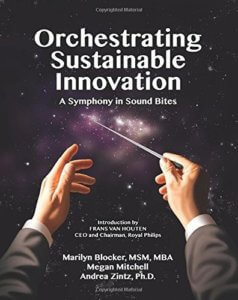Music to Our Ears: Leading Innovation in a Culture of Dissonance

Paragon Guest Author and Co-Author of Orchestrating Sustainable Innovation: A Symphony in Sound Bites: Andrea Zintz, Ph.D.
Sr. Executive Coach, Paragon Leadership International
azintz@paragon-lead.com

Based on over 35 years of experience as a leader and consultant, I believe there’s an effective leadership model for daily operations and sustainable innovation that helps leaders achieve their goals, regardless of their experience level.
This leadership model is also very useful for managing the change that inevitably accompanies innovation. Consisting of three distinct and often overlooked intentions, the goal of this framework is to shape, stimulate, and support innovation.
Shaping Innovation
To successfully shape innovation, leaders must first look strategically at the external landscape. A strategic perspective takes consideration market forces that determine the value that their organizations bring to the marketplace. Many problems require delving into root causes. An important habit of mind for shaping innovation is to see the whole system. This practice requires leaders to notice recurring patterns, attractors, and factors that can seem entangled until they detect the connections.
Leaders also shape innovation by creating structure, taking long-term views, and allowing time and space for creative thinking and idea generation. They must shape the right mindset for others by providing structural, developmental, and social support. And before leaders can accomplish this, they should consider doing the following:
- Finding the right talent by relying on non-traditional methods to recruit outside of the company’s industry.
- Seeking candidates with a balance of hard and soft skills.
- Fostering a culture of innovation by listening, asking questions of themselves and others, and exploring creative ideas that will correlate to their organization’s future needs.
- Building trust by being willing to listen deeply for what may underlie employees’ requests or demands, and help employees develop risk tolerance.
Stimulating Innovation
Leaders wishing to innovate can initiate conversations that stimulate new thinking. When they do this, they manage the creative energy that helps shape an innovation culture and engages employees so they see that they’re assets worthy of an investment of time and energy. For example, when leaders share new knowledge and facilitate provocative and engaging conversations among team members and across department boundaries they raise excitement about what may be possible. What follows are several other ways in which leaders can stimulate innovation:
- Ensure two-way, strategic communication of shared visions and values, while also encouraging employees and other critical stakeholders to see how their unique roles contribute to the organization’s mission and vision.
- Display positive body language as employees look to leaders for signals and for manifestations of both behavior and mood that indicate whether they’re well supported.
- Give clear and unambiguous signals and while providing the necessary vision and structure while still allowing partners latitude in expression.
- Demonstrate presence, vulnerability, and authenticity by asking provocative questions and engage with others in a transparent manner predicated on integrity.
Supporting Innovation
Leaders can provide support to their followers through skills and competency assessment and then through developmental efforts that often include coaching and mentoring. They also encourage innovation through their sponsorship of specific initiatives and by recognizing and rewarding their employees’ efforts to achieve agreed-upon targets. Supporting employees can take multiple forms:
- Support through sponsorship is vital to an environment of nurturance, and so is validation and praise for work well done. This kind of assistance can mitigate the threat response that many employees experience in the face of change, such as that related to uncertainty, status changes, shifts in relationships, changes in levels of autonomy, and perceptions of what’s fair or unfair.
- Demonstrate commitment by sponsoring initiatives that develop employees. Through formal coursework, coaching, and on-the-job training, leaders can strengthen their benches with potential skilled replacements at the same time that they help people close skill and competency gaps.
- Build and reward flexibility and courage as employees manage organizational change. One way in which leaders can manage change effectively is by making a clear distinction between the predictable and the unpredictable, and communicating that difference to employees. Another way in which leaders take some of the fear out of change is by involving employees in the change process through frequent communication and support.
- Identify changes to the culture that support innovations. To effect culture change, leaders must also define, model, and reward new norms and behaviors. To do this, many craft a “leadership ideal”—a vision to which others can also aspire. Additionally, leaders must be prepared to address negative behaviors when they emerge, especially those with the potential to dismantle the infrastructure that’s being created to change the organization’s culture
Concluding Thoughts
Reflecting on the key takeaways from successful leaders, people in almost any sector and industry must assertively reinvent their games and accomplish this by setting the stage for creativity and innovation. Similar to the way in which orchestra conductors bring forth music, organizational leaders can lift and inspire their followers to elicit new thinking that’s balanced with successful execution. To do that, leaders must identify current needs and anticipate future ones. Then they need to accurately position and continually reposition their organizations for successful outcomes.

The thought leaders and practitioners who we interviewed for our book, Orchestrating Sustainable Innovation: A Symphony in Sound Bites, expands on this and other leadership strategies expressed in this section and others. By addressing a broad range of topics, they share their experiences, the results of their research, and their best practices.